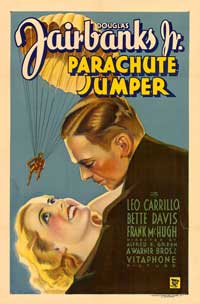Plot
Marine pilots Bill Keller (Douglas Fairbanks, Jr.) and "Toodles" Cooper (Frank McHugh) are shot down over Nicaragua. When a search party finds them drunk and unharmed in a cantina, they and the Marine Corps agree to split ways. In no time, they find employment as commercial pilots with a New York firm. Upon arrival, though, they find their new employer has gone bankrupt. Unemployed and nearly broke, they encounter a woman named "Alabama" Brent (Bette Davis) and ask her to share their apartment to save expenses. After escaping death in a parachuting stunt, Bill finally lands a job with bootlegger Kurt Weber (Leo Carrillo). Thus, both Bill and Toodles become entangled in Weber's smuggling schemes, flying in contraband liquor from Canada. On one such trip, Bill shoots down two Border Patrol airplanes while mistaking them for hijackers. Fortunately, there are no fatalities.
Meanwhile, Weber and his henchman Steve (Harold Huber) set a deadly trap for two disgruntled, unpaid ex-employees. Repulsed, Bill hands in his resignation, but Weber persuades him and Toodles to each make one more delivery. Later, Bill learns this time they are smuggling narcotics, not liquor. At the same time, the authorities close in on Weber's office. Weber and Bill elude their trap and fly a plane to Canada. Once again, Border Patrol planes give chase, shooting Weber's plane down. Afterwards, Bill persuades border officials that he is the innocent victim of "kidnapper" Weber. In the end, Toodles decides to re-enlist in the Marines. Bill proposes to Alabama, promising he can support her if he too rejoins the Corps. So Bill and Toodles return where they started. [2]
Reception
Mordaunt Hall, reviewer for The New York Times , called it "a fast-moving tale of adventure in the air and on earth ..." [8] That review summed up the format of crime and adventure in the air that had been explored in a number of other films of the period. [9] In a later review, Leonard Maltin called it a "Fast-moving, enjoyable Warner Bros. programmer." [10]
In popular culture
Clips of Parachute Jumper are featured in the prologue of the first film version of What Ever Happened to Baby Jane? (1962) as an example of the supposedly poor quality of the film work of Jane Hudson (Bette Davis) as an adult. [4]
In an interview about his film career, Douglas Fairbanks Jr. described Parachute Jumper as "awful". [11]
This page is based on this
Wikipedia article Text is available under the
CC BY-SA 4.0 license; additional terms may apply.
Images, videos and audio are available under their respective licenses.

